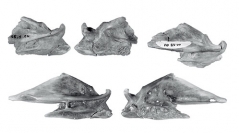

 Geodiversitas
35 (1) - Pages 49-65
Geodiversitas
35 (1) - Pages 49-65Disarticulated fossil remains of a same indeterminate perciform have been described in Neogene deposits from Africa, in Libya (Upper Miocene of Sahabi) and in Namibia (Middle Miocene of Arrisdrift), and then from Germany (Lower Miocene of Langenau). Found in association with strictly or dominantly freshwater faunas, they were supposed to be freshwater fish. However, their distribution was rather difficult to interpret and their comparison with freshwater ichthyotaxa did not permit to attribute them neither to a known genus even nor to a known family. By comparison with marine perciforms, the review of the African fossils allowed us to attribute them to the genus Argyrosomus (Teleostei, Sciaenidae) or “Meagre”. Only new fossil material and an acute study of the osteology of extant species might allow specific attribution of this bony material. These African fossils and those from Langenau constitute the whole bony fossil record of the genus Argyrosomus De La Pylaie, 1835 that is also known by otoliths from European Miocene deposits (Mediterranean and Paratethyan seas). These marine fish, today present along European and African (and also Asian and West Pacific) coasts, have certain members that frequently enter estuaries and coastal freshwater streams. So, our identification of disarticulated bony remains completes the fossil record of Argyrosomus. It allows us to date their presence along the African West coast since at least the Middle Miocene and it indicates that their affinity with fresh water existed yet in the Lower Miocene.
Sciaenidae, Argyrosomus, fossil bones, Miocene, Africa, freshwater